Site Menu:
| This is an archived Horseadvice.com Discussion. The parent article and menus are available on the navigation menu below: |
| HorseAdvice.com » Diseases of Horses » Lameness » Joint, Bone, Ligament Diseases » Epiphysitis, Physitis, and Physeal Dysplasia » |
| Discussion on Angular Limb deformity or physitis | |
| Author | Message |
| New Member: horsgran |
Posted on Saturday, Aug 16, 2008 - 8:15 am: Sire is an American Spotted Draught, dam WB, both very tall horses apprx 17hh with straight conformation. The foal was born very straight. At 6 months old he was weaned, was 13.2hh and began a very slight turned toe. He went to his new home, 5 months later he was 15.2hh. Both knees were affected by angular limb deformity. One knee first then later the other. He was in improved dairy pasture most of the time, all the time covered, was fed some grain although not sure of quantities and supplemented with a tsp of calcium a day. He did not received corrective trimming for his slightly turned toe which could have limited the problem and not monitored at all during his so fast growth. The problem was left untreated and unattended. The deformity went so bad that he had to be put down. Here are my questions? Is this genetic? Could this have been prevented? Could this have been treated successfully? What happen to that foal? Is the feeding responsible in this case? Thanks. |
| Member: lilo |
Posted on Saturday, Aug 16, 2008 - 10:17 am: I have no answers, but what a sad story. So sorry to hear that a foal had to be put down. Lilo |
| New Member: horsgran |
Posted on Sunday, Aug 17, 2008 - 4:15 am: The foal was stunning. I will try to post link with photos. He has never been lame. He was born straight with straight movements. 2 weeks after weaning at 6 months old his toe turned slightly and farrier said it would correct itself with appropriate trimming. The foal was sold soon after weaning and buyer was told to monitor the toe with her farrier. 5 months later the damaged was done and so bad that it could not be managed in anyway. Grew 8 inches in 5 months. The owner had a vet and he said it was inherited from the stallion. I cannot understand how he can say that and in what studies or documented information he based that statement. The stallion has nearly 20 foals (older ones are 4 years old) on the ground and none has never had that problem. The breeder proposed to take back the foal but owner refused and put it down. Not sure as a yearling anything could have been done. The angular limb deformity in this case valgus carpus went very bad. We have heard that the owner had also 3 clydies in the past that were destroyed at some stage affected with wobbler synDrOme so again a related disorder. I think owner should review her feeding management. The foal was covered at all times and I think maybe he was not synthesizing enough vitamin D. He was in improved dairy pasture with a very high carbohydrates contain and was supplemented with lot of calcium without really worrying much about the cal/ phos ratio. The soil is also very deficient in boron, copper, selenium and iodine which should have been supplemented. It is a pity breeder could not have access to the foal to have some blood tests done and X-rays were not either provided for inspection. It is really a tragedy, such beautiful foal wasted that way. |
| Moderator: DrO |
Posted on Sunday, Aug 17, 2008 - 10:47 pm: Welcome Rosemary,I am saddened to read the history of this poor foal. These are not questions we can answer about a horse in particular but if a stallion's line has no history of throwing foals with a particular defect then there certainly is no basis for the statement this is in the stallion's genes. Most cases of acquired deformity are treatable but there are exceptions. For more on the causes of angular limb deformities, the treatment, and prognosis see Diseases of Horses » Lameness » Joint, Bone, Ligament Diseases » Angular Limb Deformities in Foals. DrO |
| Member: horsgran |
Posted on Friday, Aug 22, 2008 - 8:15 pm: Hi,I am posting some photos. First the foal very young, after he has been weaned and finally as a yearling. I made a mistake he was not carpus valgus but carpus varus with the left knee more affected than the right. 2 weeks after he was weaned he began pigeon toeing inwards on his left front foot but it was slight and could be managed by corrective trimming. Do you see any sign of angular limb deformity in the photos as a weanling? He acquired ALD between 7 and 11 months old. How to manage it at this age as the growth plates are closed. What are the treatments available? Owner consulted a vet for the foal as a yearling when the damage was done and his diagnosis was that the foal had it very young and the time frame to do something with treatment or surgery was beyond limit. He advised to put the horse down. He was mistaken as the foal did not have any sign of it before he left his breeder as a weanling so I guess nutritional imbalances (improved dairy pasture rich in carbos and proteins, a table spoon of calcium a day, pasture deficient in copper and foal heavy covered including neck at all times), fast growth and weight bearing would have contributed to physitis and consequently ALD while the vet's owner says he got severe physitis due to the ALD (due to increased compressive forces at the growth plates). What come first? I would have thought physitis comes from ALD when ALD is congenital or present soon after birth while in older foals it would seem more logical that physitis comes first then ALD. I would have thought also if the foal had ALD as a weanling as it has ben wrongly diagnosed what vet would have prescribed calcium tablets without first determine if there is an imbalance and what vet would expect that a 6 months old ALD foal would straighten himself with time and calcium tablets. Horsgran 1: 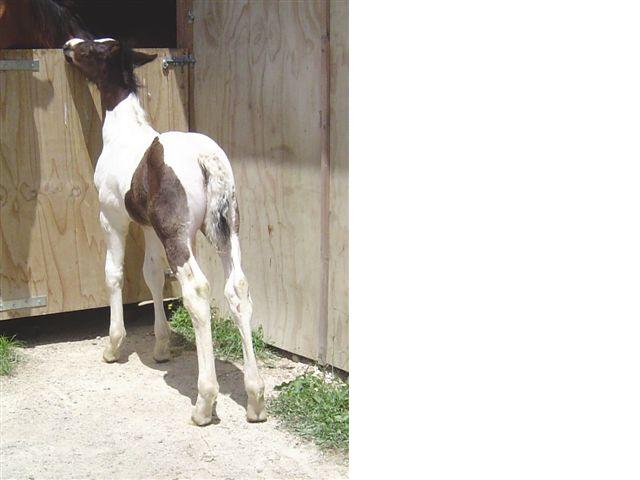 2: 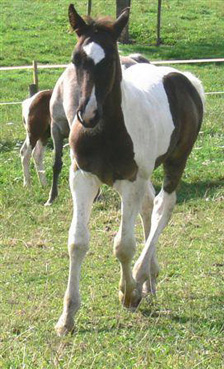 3: 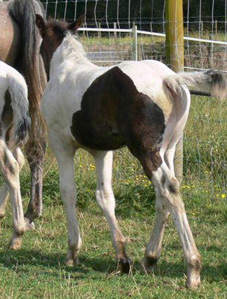 4: 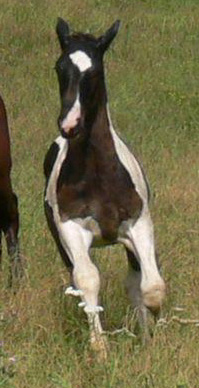 5: 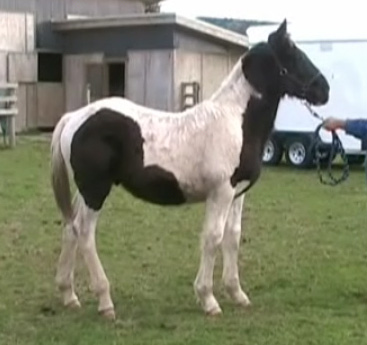 6: 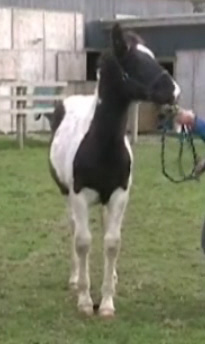 7: 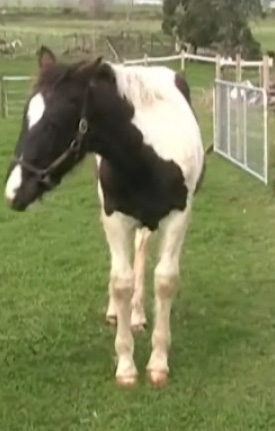 8: 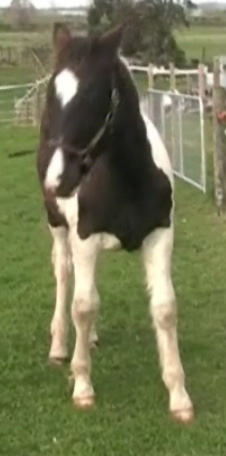 9: 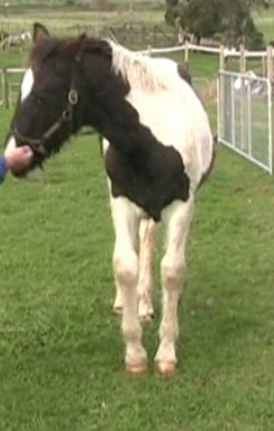 10:  11: 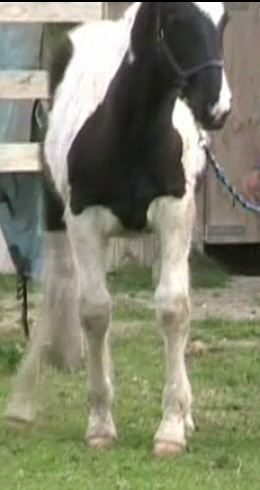 12: 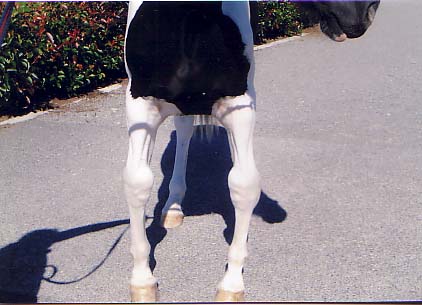 13: 
|
| Member: juliem |
Posted on Saturday, Aug 23, 2008 - 12:26 am: Wow, what a sad, remarkable series of photos! I've never seen anything like that. I hope you find some answers. |
| Member: paardex |
Posted on Saturday, Aug 23, 2008 - 9:31 am: What a horrible change! Surely there must have been something wrong with the food and the way he lived? If born with this disease wouldn't it have been visible much earlier? |
| Member: lilo |
Posted on Saturday, Aug 23, 2008 - 5:24 pm: Very, very sad. So sorry to hear about this. Lilo |
| Moderator: DrO |
Posted on Sunday, Aug 24, 2008 - 7:27 am: I believe that your assessment of cause, effect, and treatment premature and possibly incorrect. Before prevention and treatment can be discussed a diagnosis is needed. The first step to a diagnosis will require radiography as there are other possibilities like collapse of a carpal bone. Both physitis and carpal bone collapse are usually diseases of the young foal but this does appear to be an unusual case.DrO |
| Member: horsgran |
Posted on Sunday, Aug 24, 2008 - 8:18 am: Hi All,I am not the foal's breeder but a dear friend who is so depressed by the whole story that I am trying to find some answers as she has been accused by the buyer to have sold a defective foal and said it is her fault. The vet's owner diagnosed severe physitis as a result of angular limb deformity (due to increased compressive forces at the growth plate)when the foal was a yearling. He also said that the foal must have had the problem at birth or soon after birth and should have been x-rayed at 2 months old however he never saw the foal at that age. There was no visible sign of it so how the breeder would have known? He also said the buyer saw very clearly the foal had angular limb deformity as a weanling but what I see in the photos as weanling is an inward pigeon toe. Could this be a precursor sign of ALD? Thanks all for your answers. Horseygran |
| Member: juliem |
Posted on Sunday, Aug 24, 2008 - 10:31 am: I've never had to deal with anything like this, but I would have thought it to be a very red flag that he started to toe in at six months after being pretty straight. In hind sight I would think that the toeing in was a result of the uneven loading of the knees??? Sadly, trying to pin blame is not very productive to learning from this situation and insuring it doesn't happen again. I think if the buyer saw this foal as he appeared in the photos after weaning, he bought his own problem. Unless the breeder assured him that it was no big deal and could be reversed with trimming, which at six months would be pretty much impossible IMO. I think there is research regarding this. |
| New Member: twadwis |
Posted on Monday, Aug 25, 2008 - 10:40 am: Just something I noticed (and I'm admittedly anal about hoof angles), in the last couple of photos the feet appear to have high heels. This is a stretch because we really don't have any good angle or actual feet shots (and why not??) but the hairlines in the early photos would suggest that for some reason the normal looking angles in the weanling photos appear totally different than the later one.What I'm suggesting here is anytime you start seeing angular changes in growing colts it's important to double check for hoof angles and balance. It doesn't take much lateral imbalance to mess up knees. I'm always disappointed when people don't consider that foot angles determine the load bearing angles of all the joints above the hoof. |
| Moderator: DrO |
Posted on Monday, Aug 25, 2008 - 5:36 pm: I have numbered the photos above to make discussion easier. Starting with number 11 I do see remarkable imbalance in the hooves horseygran. However I have never seen unbalanced hooves create such a change in the knees and as Julie suggest it may be that early changes in the knees are causing the rotational effects and hoof imbalances.DrO |
| Member: horsgran |
Posted on Tuesday, Aug 26, 2008 - 5:23 am: Photo 1 was taken very young then up to 4 the foal was about 3 months old, 5 to 11 the foal is 6 months old and 12 -13 the foal is a yearling. It is not easy to see the feet because of the grass. I extracted the photos from a DVD showing the foal in movement. Photo 11 is not a very good shot. If you check carefully you can see an hind leg still up in the air. The breeder had just taken the foot up to show to the camera that the foal was good when handling the back legs. I copied the shot just after she let go the leg which would have created a weird imbalanced standing position.Tania when you talked the feet appear to have high heels which photos to you refer to? Thanks. |
| Member: horsgran |
Posted on Tuesday, Aug 26, 2008 - 5:58 am: Thanks everyone for your ideas. I have done some research myself and the problem could be due to different factors maybe several ones at the same time. Obviously there was an inward pigeon toeing. Not sure if it came from a rotation at the fetlock level or the knee. Maybe it came form the knee as the growth plate at the fetlock closed at 3 months old. Also it seems carpus valgus is more common than varus. Quite strange bilateral varus in this foal. The foal had certainly joint and/or bone problems I'm not denying it but it worsened I think due to lack of management and treatment. He should not have deteriorate that much. He had a very rapid growth in 4 months. The grass of his paddock was providing 19% energy (dairy improved pasture) with a high contain in protein between 16 to 19% and high carbohydrates. Ca was 0.65% and Phos 0.40%. The foal was also supplemented with a table spoon of calcium a day although as he was covered at all times including the neck not sure he was able to fix enough vitamin D to assimilate the calcium. He was also deficient in copper and zinc as the soil and pasture are very deficient of these minerals. I found some literature that copper deficiency can induce DOD also zinc deficiency and excess will have an impact. This has been positive in a certain way because next time I breed my own foals I will be more aware of their legs and will get the vet to x-ray early if any suspicion of anything than to say sorry too late!! |
| New Member: twadwis |
Posted on Tuesday, Aug 26, 2008 - 5:49 pm: I'm looking at hairlines in the photos. In the early ones you can easily see a sloping line downward to the heels. In the last two, even though they are a front view you can see the foot is 'tall', the hairline looks to be near parallel to the ground, both indicating tall heels. As Dr O says imbalances can cause big problems, I agree, especially with a young horse standing on its toes due to high heels. The photos show problems early on but after seeing the last two photos my thought are those tall, narrow (contracted?) feet added stress to those joints, if they were imbalanced, even worse. Now, all these opinions are based on photos....I can't remember, were there feet Xrays? |
| Member: ekaufman |
Posted on Wednesday, Aug 27, 2008 - 12:01 am: I have been following this thread for a while. Of course the pictures are quite sad, and it seems like a very unusual situation. It's a shame that we do not have radiographs to help interpret the images. I certainly have never seen anything quite like this result from straight mis-management, but I haven't seen everything!I have a small breeding program, and if I had bred this foal, I think I would do my very best to return the purchase price to the buyers, regardless of any management issues that might have interfered with the appropriate interventions for or management of the foal. Every foal I sell comes with a "bring it back" clause, because my goal is to have happy horses with happy owners, and I can only lose my reputation once, fairly or not. A bitter owner, even if that owner is in the wrong, can easily ruin my chances of finding good homes for future foals. That being said, I would never repeat a breeding that produced this particular outcome. I'm not a geneticist, but I find it implausible that this situation would not have at least a genetic predisposition. Poor baby horse. |
| Member: horsgran |
Posted on Wednesday, Aug 27, 2008 - 2:00 am: Hi,As a matter of fact the purchase price has been refunded to the buyer and the breeder asked the foal back and happy to pay the transport however the buyer refused and said to have put him down. This day no one is sure if the foal is dead or alive. Radiographs were taken but have not been presented for inspection to the breeder or his vet despite a request. The sire of this foal has more than 20 other foals on the ground, older ones being 4 years old now and no one has ever had that problem. I don't think this is to do with the sire or the dam but certainly a predisposition exist with any big tall foal (both parents are 17hh). We cannot compare with other full siblings as it was a first foal for the mare. In the future she will be rebred and foal for sure carefully monitored. It is not the same to own a foal than to own a horse. A foal requires much more commitment and monitoring. It is much more work than to put the foal in a nice grassy paddock and wait for nature to do the work. |
is The Horseman's Advisor
Helping Thousands of Equestrians, Farriers, and Veterinarians Every Day
All rights reserved, © 1997 -
